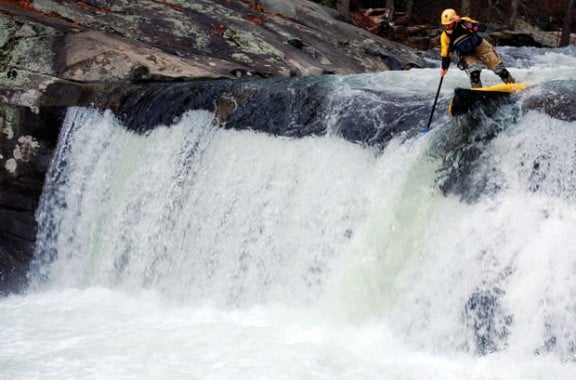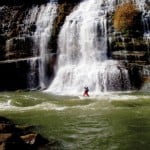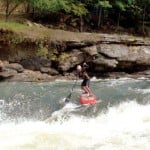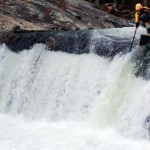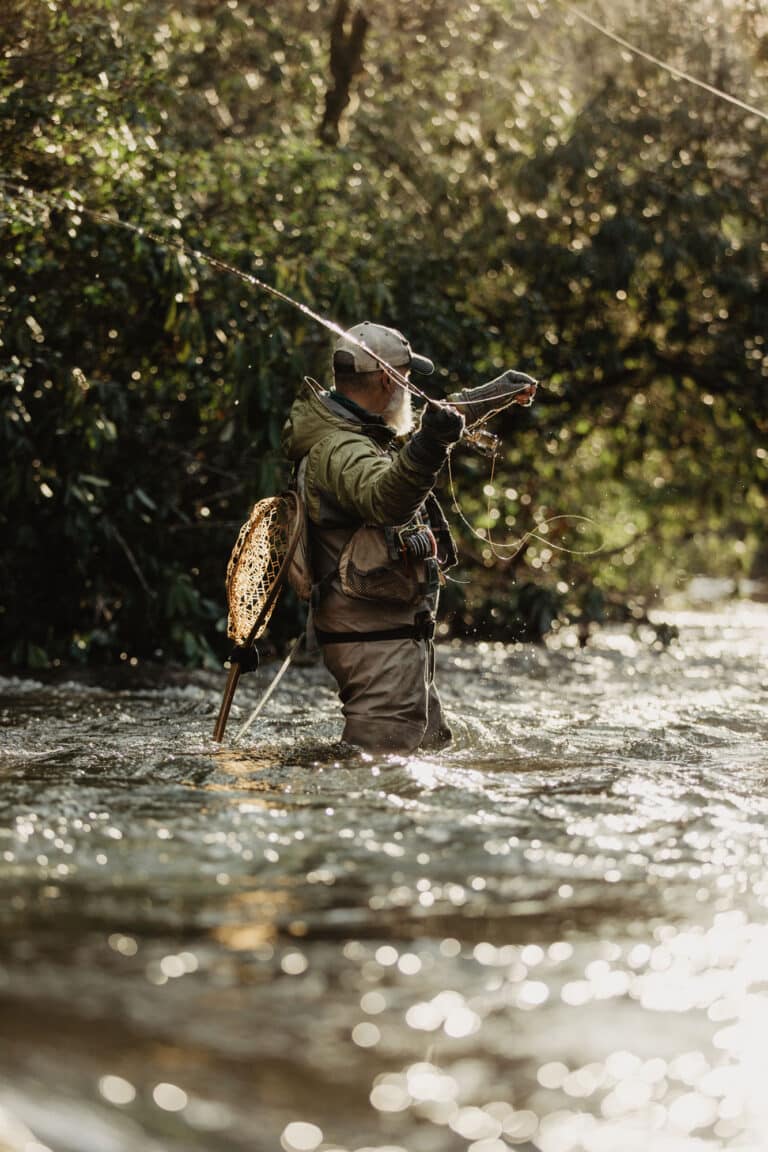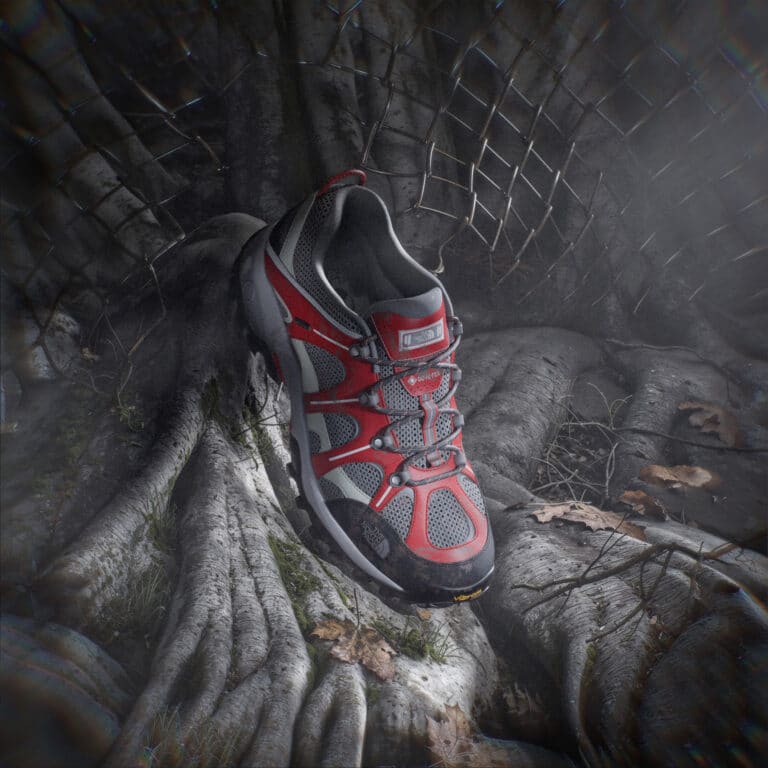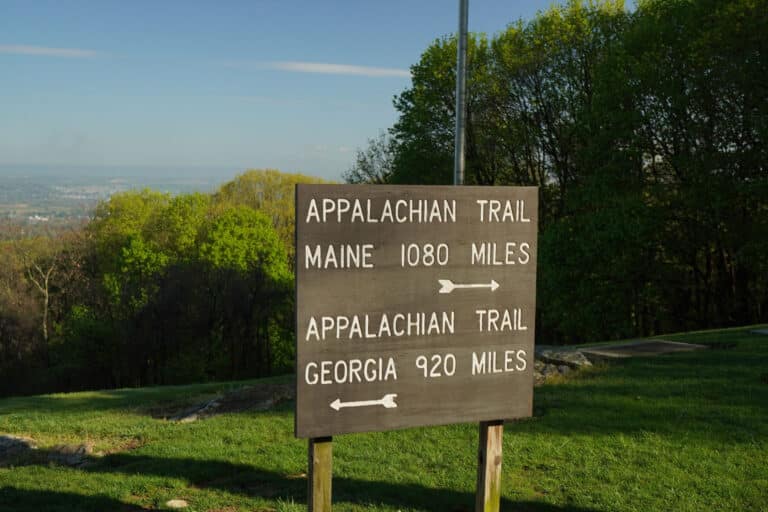Stand-up paddleboarding has been part of Hawaiian heritage for over 50 years, but it has recently jumped across the ocean to become the fastest growing paddlesport in the continental U.S. today.
Paddleboards speak to the child within. A paddleboard represents a blank slate, with infinite room for creativity and expression. Using this tool, you can explore a local lake with your family, do on-water yoga or CrossFit, surf ocean swells, tackle whitewater rivers, sail downwind with a kite, fish, deepwater solo climb. SUPs are simple, functional tools to follow your passions.
“When was the last time that you saw an 80 year old fall down, laughing hysterically, and then get back up and want to try it again?” says Luke Hopkins, owner of Stride, an inflatable paddleboard manufacturer in Blacksburg, Va.
What sets SUP apart from some other paddle sports is the fact that the learning curve is virtually nonexistent. Almost anyone can jump on a paddleboard and feel comfortable within an hour or so.
Celebrities such as Pierce Brosnan, Cameron Diaz, Lance Armstrong, and others have been seen on paddleboards, and the fitness aspect of the sport is very appealing. Like many paddlesports, the power of your stroke comes from the core, and one hour of SUP has been proven to be equivalent exercise to six hours of surfing.
The paddleboarding scene in the Southeast differentiates itself from the rest of the country in a very special way: moving water. Paddleboards are increasingly popular among whitewater kayakers in the region who are looking for a new challenge.
I learned about this appeal firsthand during my inaugural SUP attempt at the National Whitewater Center in Charlotte, N.C. I am a confident class V kayaker, but when I jumped on a paddleboard and took off down some class II rapids, it was like taking the training wheels off. The subtleties of the river are so much more defined when you are standing up and feeling every ripple and current through your feet. My entire body needed to work together as one interconnected unit to control the board, and those same rapids that I would have floated through casually in my kayak represented an awesome and infinitely challenging puzzle when confronted on a paddleboard. I spent about half the time either kneeling on or chasing the board, but I was laughing my way down the rapids for hours.
For beginners, a 10-foot or 11-foot board is recommended. This is a good mixture of stability, ease of transportation, and the versatility to sample a bit of everything. For those interested in entering the whitewater world, it is important to become educated on the pros and cons of using a leash, and if used, how to properly set up quick-release systems. River SUP may seem daunting and scary at first, but there are many excellent rivers in the area for first-timers to develop their skills safely, including the Lower Green, French Broad, Potomac, Susquehanna, Nantahala, Big South Fork, Hiwassee, and the Ocoee.
Two Southeast paddleboard leaders are Ben Friberg and Mike Tavares of Chattanooga, Tennessee. Friberg and Tavares represent the cutting edge of the inland aspect of the sport. They paddleboard regularly on the Ocoee River, a challenging Class III-IV run, using river-specific boards by manufacturer BadFish, along with protective gear to shield them from the uncertainties of standing up on steep, rocky rivers.
While inflatable boards are at the forefront of the recreational SUP movement due to their portability, weight, and soft, forgiving construction, some advanced SUP athletes like Tavares and Friberg choose rigid boards made out of fiberglass or other materials. These boards slide more smoothly over rocks and allow for more rigidity and sharper rails for surfing.
“The first time that you peel out of an eddy on a SUP, and you commit to leaning over that edge as the board slices into the current, that’s it. The addiction starts,” says Friberg.
This summer, Friberg will attempt to break the 24 hour SUP world distance record on the Yukon River in northern Canada. This massive river drains the northern part of British Columbia and flows through the Yukon province before traveling into Alaska. It has been the site of a number of consecutive kayak distance records. Friberg and fellow paddleboarder Dan Gavere will attempt to set themselves apart from previous records through their specially designed carbon boards, whitewater experience, and river-reading abilities.
After studying river speed, wind patterns, and other knowledge gathered from locals, everything points to this attempt being a huge accomplishment for the sport. “It is going to be Mount Everest,” says Friberg. But the real spotlight, he insists, should be placed on that mighty river. “We just hope that we represent that river and river people well.”
on the fringe other edgy sports going mainstream
parkour
Parkour is a sport whose growth has been dramatically augmented by sensational Internet videos and appearances in high-profile movies like Casino Royale.
In spite of its stunt- and risk-oriented image, traceurs, or practitioners of parkour, are in fact extremely mentally and physically conditioned athletes. The sport has its roots in French military training, and essentially involves moving as efficiently as possible over obstacles in urban environments. Many refer to it as the “art of movement.”
The goal is to gain as much ground as possible at all times, and it has almost primal roots in the act of attacking or fleeing. Absorption and redistribution of energy is a primary focus, and the obstacles are used as analogies to help traceurs effectively overcome fears and pain in everyday life.
This sport carries many similarities to international athletic movements such as CrossFit, which focuses on functional fitness and holistic athletic development for a lifetime. Cityscaping, a form of urban climbing, and MovNat also have similar credos and followings.
Parkour lessons are offered across the Southeast, including Asheville Gymnastics, Virginia Tech Parkour, and Primal Fitness in D.C.
surf kayaking
Once a peripheral way for whitewater paddlers to get some laughs while on a beach vacation, surf kayaking has evolved into a vibrant and competitive sport with followers on both coasts of the U.S and worldwide.
The progression of the sport has come a long way from its roots as a part of the now defunct National Organization of Whitewater Rodeos. From these whitewater beginnings, surf kayaking has evolved into what it is today: a devout community using cutting edge designs to ride waves and compete like board surfers.
The introduction of composite technology is one factor that has certainly played a large role in the sport’s development. The boats are ultra-light, low rocker, and feature short sterns and fins to optimize carving power and speed down the face.
Ultimately, the draw is the same as that of board surfing: interacting with a powerful force of nature in a dynamic and beautiful way. Surf kayakers, however, have the added advantage of being able to generate more speed on the takeoff than their board surfing counterparts, as well as the ability to stay drier in cold weather, and paddle back out after a ride faster.
The Outer Banks of North Carolina generated some buzz in the international surf kayaking scene when it hosted the World Championships last October. Athletes who had previously been skeptical of conditions on the East Coast were pleasantly surprised by the beautiful waves and seamless organization throughout the event.
Spencer Cooke, long-time surf and whitewater kayaker, offers that the best way to give the sport a shot is to attend one of the competitions in the prime East season of September-October. “The community is extremely excited about seeing new faces, and is very generous as far as sharing boats and information.” Cooke follows with a word of encouragement to first-timers: “The only way to truly appreciate the sport is to try it. Words, videos, or photos can only begin to express how amazing it is.”
For more information, visit the Eastern Surf Kayaking Association at eskasurf.com.
downhill biking
There aren’t many things in life that can compare to the thrill of flying down a steep mountain trail, dodging rocks and roots, and then feeling the weightless bliss of disconnecting from reality on a jump.
Downhill biking is a sport with a very solid foundation in the Blue Ridge Mountains. Through the years, a number of bike parks have shuttled riders on their chairlifts for summertime descents of the steep grades. The most well-known of these is certainly Snowshoe Mountain, which features a wide network of trails on both sides of the mountain, and everything from beginner to pro-level terrain.
Snowshoe is also a part of the Southeast’s yearly race series, hosting four races each summer. Other epicenters include Paris Mountain and Clemson in South Carolina, Diablo Freeride Park in New Jersey, and the resorts surrounding Boone, N.C. Beech Mountain (http://basecamp.blueridgeoutdoors.com/?p=2578) is enjoying its second year as the host of the US National Championships in 2012, and will continue to challenge the best riders from across the country.
The Southeast’s rise as a downhill destination is supported by a strong foundation of youth development programs. Local pro rider Chris Herndon is the head coach for the GROM (Gravity Racers On a Mission) team. This group of youngsters is coached on the intricacies of winning bike races, and is already taking the circuit by storm with wins in Junior and Category 1 (Expert Men) classes.
Collegiate racing is also on the rise, with active programs at schools including Brevard, Virginia Tech, WVU, Warren Wilson, UNCA, Lees McRae, and Clemson. For some of these schools, such as Warren Wilson, the mountain biking team represents the pride and focus of their athletic program.
Downhill racing in the U.S. received a surge of energy in 2011, when Aaron Gwin became the first American ever to win the coveted World Cup overall title. The momentum from this and other American contributions to the sport will surely continue to drive the growing scene in the Southeast.
For more information, visit pinkbike.com or gromracing.com, or check out the Southeast forum at ridemonkey.com.
